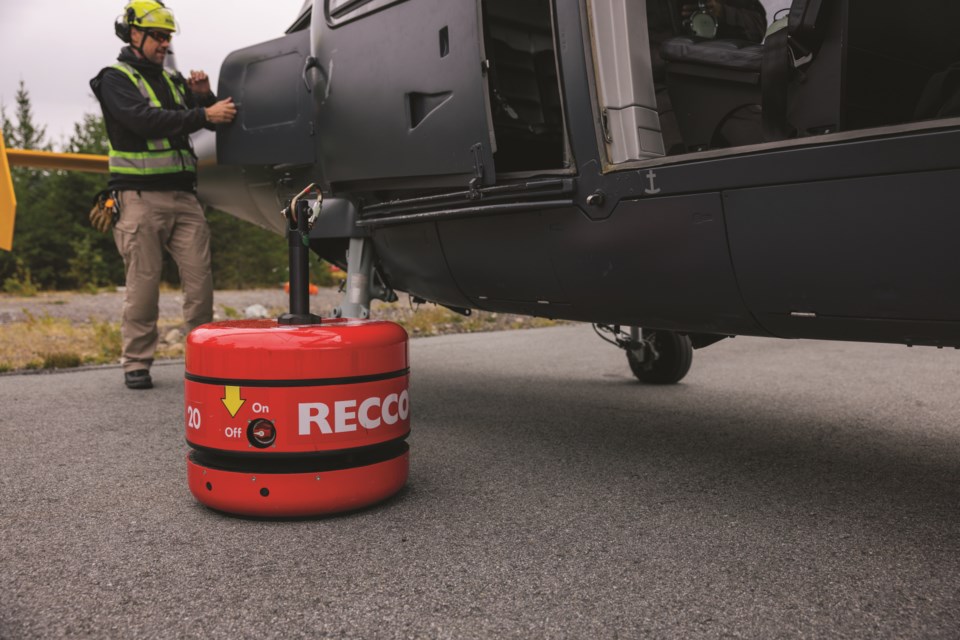Last column, I covered the evolution of avalanche transceivers. This time I’ll look at something related, far more ubiquitous, and which, until a fortuitous confab in Squamish with Helly Hansen and its search-and-rescue (SAR) partners this fall, I knew almost nothing about: the RECCO system.
To begin, imagine the Holy Grail for SAR organizations: to make more people more searchable, and that this has become imperative with the explosion of backcountry travel. As it turns out, this was RECCO’s mission from the outset and, like the transceiver story, it started with an avalanche.
On Dec. 30, 1973, Magnus Granhed witnessed an avalanche in the ski resort of Åre, Sweden. No one had rescue equipment at the time, but after hours of random searching and digging, two bodies were uncovered. One turned out to be Granhed’s friend, and he couldn’t help but think there had to be a faster way to search for victims. Convinced the answer was in electronics, and working with engineers at the Swedish Royal Institute of Technology, they hit on the idea of using harmonic radar, in which a signal sent from a device at one frequency bounces back at double the frequency from a reflector source; the reflector would be on a buried person, and the sender-detector held by the searcher. By the early 1980s, they had a handheld detector prototype—the R1. At 16 kilograms, it was cumbersome and had a range of only a metre, but things moved quickly from there.
One of the system’s first demonstrations was in 1982 in the Austrian Tyrol, with media, avalanche specialists and SAR folks on hand. Feedback was encouraging enough that RECCO was founded as a company the following year, introducing its first small, attachable reflectors to the market. In 1984, Trappeur ski boots (later bought by Rossignol), became the first brand to integrate RECCO reflectors into its product; in 1986, French steep-skiing pioneer Patrick Vallençant’s Degre7 was the first clothing brand onboard, while Swatch added reflectors to its popular outdoor watches with the tagline “Fun and Safety.” In 1992, working with NATO, the company equipped the Norwegian Armed Forces.
By that point, the R1 was long gone, with new iterations following the arc of technology to become smaller, easier to carry and more accurate. By 1995, the detector unit had been reduced to 1.6 kg, and in 2009 could search both RECCO reflectors and avalanche transceivers.
Today, the detector is barely a kilo, has a 20-metre range, and some 2,200 reside with 900 ski resorts and rescue organizations in 28 countries worldwide. Intended as a complement to avalanche beacons, probes, and rescue dogs, ski patrols also put them in the nose cones of avalanche bombs so they can more readily find unexploded ordinance, and athletes competing in the Freeride World Tour are equipped with reflectors as part of their mandatory safety gear.
The passive transponders—four grams each, no battery, unlimited lifetime—are now incorporated into the products of 150- plus outdoor brands, including helmets, pants, backpacks, climbing gear, jackets and boots. Helly Hansen has been a strong RECCO supporter for 15 years, and while it has practical reasons for working with SAR teams (for instance, several of its technical jackets were developed with insights from Squamish Search and Rescue) the RECCO association is more egalitarian: Helly is on a mission to make everyone in the outdoors searchable, encouraging other brands to get onboard. In 2018, RECCO introduced its own consumer products—including a belt and freestanding reflectors to stick on various pieces of gear. Because detection is aided by the angle of the transponder, the more you have on you, the more detectable you are. And why does that matter? Because now it’s not just about finding someone buried in an avalanche, but lost in the wilderness in any season.
While Air Zermatt SAR got involved n 1983, and RECCO’s first live-recovery occurred in 1987 in Lenzerheide, Switzerland, when a missing woman was found by a searcher carrying a RECCO unit while riding in a helicopter, RECCO’s first dedicated SAR Helicopter Detector wasn’t introduced until 2015. Designed for use by any SAR group that has flight capability, the detector is hung below a helicopter and has Bluetooth autonomy with a reader in the aircraft. Austria is the first country to be fully covered by the system, and Switzerland, Italy, Sweden and Norway aren’t far behind.
There are currently 30 units deployed worldwide, with one in Alberta and three in B.C.—including North Shore SAR—poised to change the backcountry search game. With the unit suspended 100 metres above a landscape, the heli can run a grid search covering a 100-metre wide swath at 100 kilometres/hour—about 30 football fields per minute. Thinking dense trees might be a problem, North Shore SAR ran a demonstration in a place notorious for thick trees—Lynn Canyon.
The successful shakedown proved useful: in March 2020, a hiker missing for six days near Lion’s Bay was located in avalanche debris using the heli- mounted RECCO unit. Although this instance was a body recovery, it proves the potential for locating any lost individual wearing a RECCO reflector when conventional means (cell-phone signal, trip-plan details) aren’t available. Basically, an inexpensive way to locate anyone and everyone—Granhed’s mission from the beginning.





